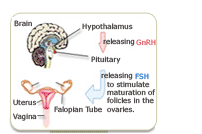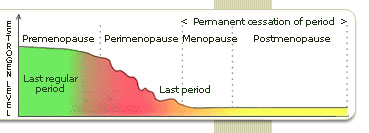34 MENOPAUSE SYMPTOMS |
HEALTH CENTER |
|
| |
|
|
|
|
|
Although the term menopause is often used to refer to the entire period in a woman's life when she stops menstruating and loses her fertility, in fact menopause is only one stage in this transition. Menopause can be divided into four distinct stages (premenopause, perimenopause, menopause, and postmenopause), each with its unique changes, symptoms, and challenges. Keep reading to learn more about the stages of menopause.
Premenopause
Uncomfortable symptoms such as fatigue, unusually intense PMS, and irregular periods are often accepted as matter of course by women in middle age, who may not be aware of the actual cause of these symptoms. In fact, these may be symptoms of premenopause, the first stage of menopause, which women may experience as early as in their thirties.  |
Perimenopause
The experience most women imagine as menopause (a tumultuous time of hot flashes, unpredictable moodiness, and physical and emotional upheaval) actually corresponds to the stage of menopause known as perimenopause, the years immediately preceding menopause when the body prepares to stop menstruating. Most women experience their most acute symptoms during the transitional phase of perimenopause.  Menopause
Menopause
After having gone through the gradual changes of premenopause in her thirties and the turbulent symptoms of perimenopuase in her forties, around the age of fifty women will finally go through the menopause transition, which will usher her into a new stage of life, free of menstruation and childbearing concerns.  Postmenopause
Postmenopause
Postmenopause, the last stage of menopause, can be thought of as a "graduation" from the tumultuous ups and downs of perimenopause. In the same way that hormone levels eventually settle down after puberty, after menopause hormonal levels will even out and the body will adapt to this new phase of life. Many women find postmenopause the most liberating time of their lives.  |
|
| |
|

|
|
Menopause Stages, different for each women |
|
Menopause occurs in various stages, but not all stages are the same for each women and not all women go through the all the prescribed stages. Here we discuss the various informative solutions women can adopt to help get through... |
|
|
|
|
|
|
|
|
|
|
| |
| |
|
|
The symptoms of menopause are caused by fluctuating levels of estrogen, progesterone and testosterone hormones. There is no way to reverse menopause, but its symptoms can be effectively managed with a variety of treatment options. |
|
|
|
Treating Menopause Symptoms with
MacaActive Supplements |
Hormones play an essential role in several areas of the body. When hormone levels decline during menopause, the health implications can be significant, and often even more so for women who go through early menopause. As women begin to notice the symptoms of hormone deficiency, they may want to consider taking steps to stabilize their hormonal production.
Today, there are three effective ways to normalize hormonal levels: lifestyle changes, alternative medicine and drugs & surgery.
|
|
 |
Lifestyle Changes:: This first level of treatment involves no risk, but may be the hardest way to go because you'll have to restrict yourself from many things. That's why most people consider the next level of treatment, alternative medicine, which has proven to be excellent for treating menopausal symptoms in a safe and natural way.
|
|
 |
Alternative medicine: There are two types of herbal supplements for treating menopause symptoms: those containing phytoestrogenic herbs, and those containing non-estrogenic herbs. Phytoestrogenic herbs (like Black Cohosh) are filled with phytoestrogens, which are similar to estrogens. They can increase low estrogen levels by replacing some of the missing estrogen hormones. This isn't the best solution, however, because your body will become less responsive to producing estrogen on its own, causing a further decrease in body-own hormone levels. Unlike phytoestrogenic herbs, non-estrogenic herbs don't contain estrogen, but they nourish the hormonal glands to work more efficiently. This ultimately results in balancing not only estrogen, but other necessary hormones, as well. Using non-estrogenic herbs is one of the safest and best ways to treat menopause symptoms naturally.
An excellent example of a safe and effective non-estrogenic herb for hormonal imbalance is herbal MacaActive. What makes MacaActive so special is its ability to balance hormonal levels in women by nourishing the hormonal glands. In this way, it alleviates most disorders related to hormonal imbalance.  to read more about MacaActive.
|
|
 |
Drugs and Surgery: This level of treatment has the highest risk and often the highest cost. The most common drug therapy for treating menopause symptoms in the US is hormone replacement therapy (HRT). There's no doubt that this is the quickest and strongest way to combat hormonal imbalance. Unfortunately, it entails serious side effects and increases the risk of different types of cancer in women. If you still want to consider this approach, see your doctor to become better informed about what this treatment option involves.
|
|
A safe way to balance hormones:
Non-estrogenic herbs are the most effective solution for treating hormonal imbalance and its related symptoms.
MacaActive is an excellent non-estrogenic herb. It's simple: rather than putting hormones from the outside into your body artificially, MacaActive stimulates your hormone glands into producing the necessary hormones naturally. This is what makes MacaActive supplements so unique.  to read all about MacaActive. |
 |
|
 |
|
|







